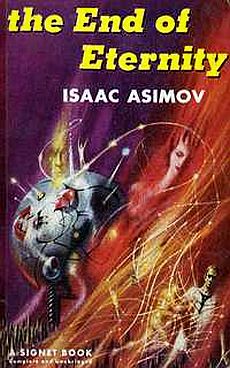|
The End
of Eternity - Isaac Asimov
|
||||
|
I discovered Asimov in 1954, when the Swedish science fiction magazine Häpna! was launched. I borrowed "I, Robot" from a public library and was captivated by his charming stories about Susan Calvin and her robots with their "positronic" brains. (Just a few years ago, it lent its name to a film with a robot theme. Unfortunately, the film "I, Robot" turned out to have very little in common with the original collection of stories.) I then started reading some of his SF novels with names like "The Caves of Steel", "The Stars, Like Dust", "The Currents of Space", before hitting upon "Foundation". The Foundation series describes the downfall of a Galactic Empire and the efforts of a society of "psychohistorians" to re-establish a galactic civilization within a thousand years, thereby saving the Galaxy from the 30,000 years of chaos and suffering that would otherwise follow. The stories seem to be modeled on the fall of the Roman Empire, the Dark Ages, and the Renaissance. [Nobel prize winner Paul Krugman has recently (2012) written an interesting essay on the Foundation series.] The End of Eternity has a different theme, although the concept of social engineering recurs. Here, time travel has been invented. "So, what else is new", you might say with a yawn, thinking of the old paradox of going back in time to murder your own grandfather, or of H. G. Wells The Time Machine, or of Mark Twain's A Yankee in King Arthur's Court, or of movies such as The Final Countdown, where a nuclear aircraft carrier is brought back to WW2, and the Back to the Future trilogy. Asimov's novel is a much more ambitious and interesting attempt to work out and discuss the possible consequences of time travel as such. Time travel is envisaged as being similar to travelling in an elevator in a shaft between the different centuries and millenia. When you step out of the "kettle", you still remain in a separate domain of reality, "Eternity", where "physiotime" passes normally. There are no paradoxes as long as you stay in "Eternity", regardless of any time travel. It is only when you leave this domain that you enter the normal temporal world. "Entry into Time was much more complicated than mere passage between Eternity and the kettle shafts."
"Eternity" is an all-male dominion, where scientists and technicians are working to increase human happiness by selectively changing temporal reality. The holy grail of their profession is to plot and implement the "Minimum Necessary Change" to accomplish the "Maximum Desired Response", which will improve the world, perhaps by averting a war or finding a cure for a disease. "If some lives were shortened, more were lengthened and made happier. A great work of literature, a monument of Man's intellect and feeling, was never written in the new Reality, but several copies were preserved in Eternity's libraries, were they not? And new creative works had come into existence, had they not?" To have the story make sense, Asimov had to stipulate that Reality has a certain inertia, so that the effects of a Reality Change will gradually dampen out and leave the distant future ("upwhen") unchanged. Once you accept the premises of the story (manage to "suspend disbelief"), you have to admire the ingenuity of Asimov's vision. "Eternity" stretches forever, and taps energy from the Sun when it goes nova in 5 billion years. But mysteriously, the period A.D. 7 million to A.D. 15 million is inaccessible to "Eternity". Past A.D. 15 million, mankind has gone extinct, so there is no point going that far "upwhen". Here and there Asimov uses throwaway lines to suggest, rather than describe, the characteristics of culture in different centuries. "In fact, good cigarettes are made only in the 72nd and mine have to be specially imported from there." - "The 2481st is the only Century to develop electro-gravity space-travel... It's a pity we must Change away from it. A pity."
Asimov has been criticized for his stereotyped dialog, his shallow characterizations and, in particular, his inability to credibly depict women. This never mattered much to me; what attracted me was the plot and the ideas in his works. Besides - and not surprisingly, given his career as a professor of biochemistry - the animosities and jealousies exhibited by some of his scientist characters ring quite true to me :-) What Asimov wanted to explore in The End of Eternity was two conflicting views on "the pursuit of happiness": 1) Maximizing security and minimizing suffering. 2) Per aspera ad astra (literally!). It is clear where his own preference lies: "Any system which allows men to choose their own future will end by choosing safety and mediocrity, and in such a Reality the stars are out of reach." I find myself agreeing, up to a point. While a risk-averse society would probably have condemned us to remain in our caves forever back in the stone age, in our present predicament a little risk aversion may not be such a bad idea? I hasten to add, that I do not advocate repression, military force and wall-building as suitable tools for enhancing stability. However, what interests me even more than Asimov's moral dilemma, is the nature of Reality, and the puzzling questions that Asimov's novel raises on that subject. It seems to me that the very concept of "Reality Change" opens the possibility that Time may have several dimensions, just as Space does. "Change" and "Time" are closely related. In the absence of change it would be meaningless to speak of time. We may think of the Universe as everything that exists at a given moment, and that the Universe evolves as time passes, but we may equally think of the Universe as a static, unchanging structure embedded in four-dimensional space-time (space-time being itself a feature of the physical Universe), "Reality", where everything that has happened and will happen "co-exists" (at least "in the eye of God"!). To clarify this, consider an ant moving on a two-dimensional surface. You may depict its motion in a two-dimensional diagram dynamically by tagging its position with the corresponding time, or perhaps by animating the diagram so you can watch the ant move as time progresses. Or you can draw its motion in a three-dimensional diagram by adding a time axis in the third dimension. Its motion will then be represented as a static, unchanging "world line" in three-dimensional space-time. Personally, I prefer this second perspective. It seems intuitively appealing to me that the past should be considered as just as real as the present and the future, and, in particular, that the present should not be accorded any special status. - Amusingly, this perspective is shared by the Tralfamadorians in Kurt Vonnegut's Slaughterhouse Five: The Universe does not look like a lot of bright little dots to the creatures from Tralfamadore. The creatures can see where each star has been and where it is going, so that the heavens are filled with rarefied, luminous spaghetti. And Tralfamadorians don't see human beings as two-legged creatures, either. They see them as great millipedes - 'with babies' legs at one end and old people's legs at the other'. Now, if "Reality" itself changes, this would mean that our "static" Universe changes. But there can be no Change in the absence of Time. (Or can it? I am less positive that Change requires Time than that Time requires Change.) And this Time could not be our familiar time in space-time. One might then propose that a Reality Change does not in fact wipe out the existing reality (just as the 21st century is no more "real" than the 20th century). A Reality Change would allow us to move from one reality to the next. We may think that we have altered the existing reality, but all we have done is develop a method for travelling between separate but equally "real" realities. What the "Eternals" in Asimov's novel do, is not to change reality, but to decide in which reality they prefer to dwell.
Is this just a metaphysical speculation without meaning, along the lines of the scholastic debate on how many angels can stand on the point of a pin? Well, there is one way to find out. Invent a time machine, travel back in time to look up your paternal grandfather before he met your grandmother, then kill him. If you still exist, then I am right and you have travelled to a new reality where you, but not your father, nor your younger self, will continue to exist. Good luck! If you can evade criminal justice, you will be able to build an immense fortune based on your knowledge of future events. - Meanwhile, in the present reality, you will just have vanished without a trace, thus discouraging all further attempts at time travel :-) When it comes to Isaac Asimov himself, I could just as easily put him under the heading "Things that surprise me" as under "Books". What I have in mind is his remarkable productivity, and especially the enormous range of his works. Asimov was not just a prolific science fiction author; he wrote mysteries, collected dirty limericks, wrote essays and introductory books in just about all branches of science, and in addition several books on history and literature. Here is a list of 1600 of his essays! He must have read thousands of books in preparation for his own works, and even then, he must have been able to type even faster than he could read! Here is the Wikipedia entry on Asimov. And here is a site dedicated to his work, with plenty of useful links.. |
 This
is my favorite among the many fine science fiction novels by Isaac
Asimov. It is unusual on two counts: it is not about robots
or about a future human galactic civilization, and it concerns time
travel.
This
is my favorite among the many fine science fiction novels by Isaac
Asimov. It is unusual on two counts: it is not about robots
or about a future human galactic civilization, and it concerns time
travel.
 The
plot thickens when the hero of the story, a mere technician, falls
in love with a woman in the 482nd century and discovers that she
is going to be wiped out by an imminent Reality Change. When he
makes an excursion into Reality, he nearly runs into himself. While
this is taking place, there is also a project of crucial importance
in progress: to send someone back in time past the time when "Eternity"
was established, in order to inspire the invention that will make
time travel possible in the first place!
The
plot thickens when the hero of the story, a mere technician, falls
in love with a woman in the 482nd century and discovers that she
is going to be wiped out by an imminent Reality Change. When he
makes an excursion into Reality, he nearly runs into himself. While
this is taking place, there is also a project of crucial importance
in progress: to send someone back in time past the time when "Eternity"
was established, in order to inspire the invention that will make
time travel possible in the first place!